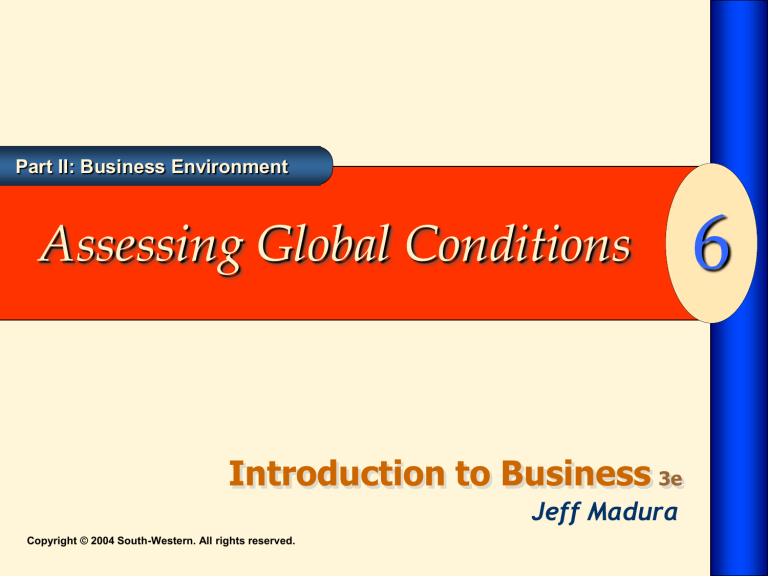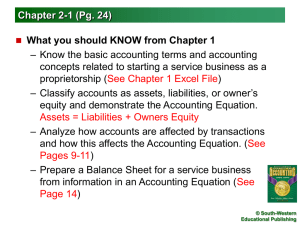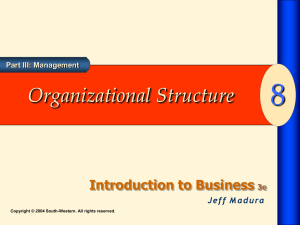Introduction to Business 3e - Jeff Madura

Part II: Business Environment
Assessing Global Conditions
6
Introduction to Business
3e
Jeff Madura
Copyright © 2004 South-Western. All rights reserved.
Learning Goals
•
Explain motives for engaging in international business.
•
Describe global opportunities.
•
Describe how firms conduct international business.
•
Explain influence of foreign characteristics on a firm’s international business.
•
Explain how movements in exchange rates can affect business performance.
Copyright © 2004 South-Western. All rights reserved.
6 –2
Assessing Global Conditions
Copyright © 2004 South-Western. All rights reserved.
6 –3
Motives to Engage in
International Business
•
Attract foreign demand
– Competition may prevent firm from increasing market share in U.S.
– Changes in consumer tastes may decrease demand in U.S.
•
Capitalize on technology
– Expand into countries where technology is not as advanced.
Copyright © 2004 South-Western. All rights reserved.
6 –4
The Coca-Cola Company’s Global Expansion
Copyright © 2004 South-Western. All rights reserved.
Exhibit 6.1
6 –5
Approximate Hourly Compensation Costs for Manufacturing across Countries
Copyright © 2004 South-Western. All rights reserved.
Exhibit 6.2
6 –6
Motives to Engage in
International Business (cont’d)
•
Use inexpensive resources
– Find locations where land and labor are inexpensive.
•
Diversify internationally
– Reduce risk and increase performance stability by selling in other countries.
– Geographic diversification reduces exposure to economic risk in U.S.
Copyright © 2004 South-Western. All rights reserved.
6 –7
Dupont’s Geographic Diversification
(measured by annual sales in millions of dollars)
Source: 2001 annual report
Copyright © 2004 South-Western. All rights reserved.
Exhibit 6.3
6 –8
Global Opportunities
•
Opportunities in Europe
– Single European Act
Created more uniform regulations
Removed taxes on goods traded between member countries
Increased competition
– Removal of the Berlin Wall (1989)
Encouraged free enterprise and privatization of businesses
– Inception of the Euro
Allows single monetary policy
Eliminates transaction costs
Copyright © 2004 South-Western. All rights reserved.
6 –9
Global Opportunities
•
Opportunities in Latin America
– NAFTA
Eliminated trade barriers between U.S.,
Mexico, and Canada.
U.S. firms have moved production to
Mexico to reduce costs.
U.S. firms now export products to Mexico.
– Uruguay Round GATT
Removed import trade restrictions over 10 years among 117 countries.
World Trade Organization (WTO)
Copyright © 2004 South-Western. All rights reserved.
6 –10
Global Opportunities
•
Opportunities in Asia
– Large population base
– In 1990s many Asian countries reduced their excessive restrictions on foreign investment
Easier for foreign firms to acquire Asian companies or negotiate licensing agreements with Asian firms.
– Asian economic crisis
Forced many local firms into bankruptcy
Created opportunities for foreign firms to acquire struggling Asian companies
Copyright © 2004 South-Western. All rights reserved.
6 –11
Foreign Expansion in the U.S.
•
Foreign firms expanded into the U.S. by:
– Establishing new subsidiaries.
•
– Acquiring U.S. firms.
U.S. industries are susceptible to foreign competition
– U.S. firms in labor-intensive industries must compete with foreign firms’ lower labor costs.
– Foreign-made products may be perceived as higher quality than U.S.-made products.
Copyright © 2004 South-Western. All rights reserved.
6 –12
International Business
•
•
•
•
Importing
– The purchase of foreign products or services
Exporting
– The sale of products or services to purchasers residing in other countries
Direct foreign investment
– A means of acquiring or building subsidiaries in one or more foreign countries
Strategic alliances
– A business agreement between firms whereby resources are shared to pursue mutual interests
Copyright © 2004 South-Western. All rights reserved.
6 –13
Importing
•
Involves the purchase of foreign products or services:
– U.S. consumers purchase foreign automobiles, clothing, cameras, etc.
– U.S. firms import materials or supplies that are used to produce products.
•
Trade barriers restrict importing
– Tariffs are taxes on imported products.
– Quotas limit the amounts of specific products that can be imported.
Copyright © 2004 South-Western. All rights reserved.
6 –14
Exporting
•
Involves the sale of products or services to purchasers residing in other countries
•
U.S. Balance of Trade
– The level of U.S. exports less the level of its imports; if imports are greater than exports, the result is a trade deficit.
•
Internet facilitates exporting
– Provide information to prospective importers
– Accept orders online and track shipments
Copyright © 2004 South-Western. All rights reserved.
6 –15
Trend of U.S. Exports and Imports
Copyright © 2004 South-Western. All rights reserved.
Exhibit 6.4
6 –16
Foreign Direct Investment
•
Investments in acquiring or building subsidiaries in one or more foreign countries to:
– Reduce transportation costs.
– Overcome trade barriers
– Acquire advanced technology by offering incentives to firms to establish subsidiaries.
– Reduce labor costs by shifting production facilities to a developing country with lower labor costs.
Copyright © 2004 South-Western. All rights reserved.
6 –17
Strategic Alliances
•
Various types of alliances between U.S. and foreign firms can be made:
– Joint venture involves an agreement between two firms about a specific project
U.S. firm makes the product, foreign firm sells the product in their home country.
Two firms share production of the product - common in the auto industry.
– International licensing agreement
Firm allows a foreign company (licensee) to produce its product according to specific instructions in exchange for a licensing fee.
Copyright © 2004 South-Western. All rights reserved.
6 –18
Influence of Foreign Characteristics
•
Culture
– Tastes, habits, and customs vary by country
– U.S. products might need to be adjusted to fit the culture
•
Economic systems
– Capitalism
– Communism
– Socialism
– Privatization
Copyright © 2004 South-Western. All rights reserved.
6 –19
Influence of Foreign Characteristics
•
Economic conditions
– Economic growth in foreign countries can influence demand for U.S. products:
Strong economy might increase demand.
Weak economy might decrease demand.
– U.S. firm’s exposure to foreign country’s economy depends on proportion of U.S. firm’s business conducted in that country.
Copyright © 2004 South-Western. All rights reserved.
6 –20
Comparing the Influence of the
Canadian Economy on Two U.S. Firms
Copyright © 2004 South-Western. All rights reserved.
Exhibit 6.5
6 –21
Small Business Survey
Many successful small firms rely on international sales for a significant portion of their business.
Copyright © 2004 South-Western. All rights reserved.
6 –22
Political Risk
•
Risk that a country’s political actions may adversely affect a business
– Expropriation: extreme form of risk occurs when foreign government takes over a U.S. subsidiary without compensating the U.S. firm.
More common risk occurs when foreign governments impose higher corporate tax rates on foreign subsidiaries.
Other risks impact costs of doing business in the foreign country - stringent building codes, waste disposal restrictions, and pollution controls.
Copyright © 2004 South-Western. All rights reserved.
6 –23
Exchange Rates
•
Exchange rates between the U.S. dollar and other currencies fluctuate over time
– Number of dollars needed by a U.S. firm to purchase foreign supplies may change, even if the actual price does not change
When U.S. dollar weakens - foreign currency strengthens - U.S. firms need more dollars to purchase a given amount of foreign supplies
Exchange rate affects foreign demand for U.S. products because they impact the actual price paid by the foreign customer.
Copyright © 2004 South-Western. All rights reserved.
6 –24
Example of Importing by a U.S. Firm
Copyright © 2004 South-Western. All rights reserved.
Exhibit 6.6
6 –25
business online
Copyright © 2004 South-Western. All rights reserved.
6 –26
Impact of Exchange Rates on Firm Performance
•
International trade transactions usually require the exchange of one currency for another currency
– Exchange rates vary on a daily basis.
– Exchange rate fluctuations have a favorable or unfavorable effect on firm performance.
Impact on U.S. importers
Impact on U.S. exporters
Copyright © 2004 South-Western. All rights reserved.
6 –27
Impact of Exchange Rate
Fluctuations on U.S. Importers
•
When foreign currency appreciates against the U.S. dollar–the dollar weakens and loses value
– Causes prices of foreign supplies to increase and adversely impacts U.S. firms that import supplies.
Copyright © 2004 South-Western. All rights reserved.
6 –28
Impact of Exchange Rate
Fluctuations on U.S. Importers
•
When foreign currency depreciates against the U.S. dollar–the dollar strengthens and gains value
– Causes prices of foreign supplies to decrease - reduces expenses of U.S. firms that import supplies.
Copyright © 2004 South-Western. All rights reserved.
6 –29
Impact of Exchange Rate
Fluctuations on U.S. Exporters
•
When foreign currency appreciates against the U.S. dollar–the dollar weakens and loses value
– Causes prices of U.S. products to decrease and demand to increase - has a positive impact on U.S. exporter’s revenues and profits.
Copyright © 2004 South-Western. All rights reserved.
6 –30
How Exchange Rates Can
Affect the Price of Imports
Copyright © 2004 South-Western. All rights reserved.
Exhibit 6.7
6 –31
Impact of Exchange Rate
Fluctuations on U.S. Exporters
•
When foreign currency depreciates against the U.S. dollar–the dollar strengthens and gains value
– Causes prices of U.S. products to increase and demand to decrease - has a negative impact on U.S. exporter’s revenues and profits.
Copyright © 2004 South-Western. All rights reserved.
6 –32
Example of Exporting by a U.S. Firm
Copyright © 2004 South-Western. All rights reserved.
Exhibit 6.8
6 –33
Hedging Against Exchange
Rate Movements
•
Hedging means to take actions to protect a firm against exchange rate movements
– Hedging future payments and future receivables in foreign currencies
Request forward contract at a specified exchange rate on a future date.
Rate is called a forward rate
– Reduces risk because firm knows in advance what the exchange rate will be
– Prevents both favorable and unfavorable exchange rate fluctuations
Copyright © 2004 South-Western. All rights reserved.
6 –34
Copyright © 2004 South-Western. All rights reserved.
How Exchange
Rates Affect the Degree of
Foreign
Competition
Exhibit 6.9
6 –35
Chapter Summary
•
U.S. firms engage in international business to attract foreign demand, capitalize on technology, use inexpensive resources or diversify internationally.
•
Reduction of trade barriers has increased global expansion opportunities for U.S. firms.
•
Firms conduct international business via importing, exporting, direct foreign investment and strategic alliances.
Copyright © 2004 South-Western. All rights reserved.
6 –36
Chapter Summary
•
Firms must assess culture, economic systems and conditions, exchange rate risk and political risk when entering foreign markets.
•
Exchange rate fluctuations affect importers and exporters in different ways.
Copyright © 2004 South-Western. All rights reserved.
6 –37
Business Environment
Copyright © 2004 South-Western. All rights reserved.
6 –38









